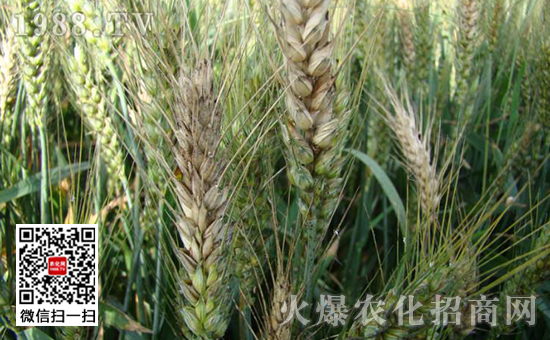Wheat scab, also known as rotten wheat head and white ear, is a fungal disease, generally reducing production by about 10%. In a pandemic year, it can reduce production by 20%-30%. To prevent and cure scab, it is necessary to clarify the law of its incidence, the influencing factors of the disease, the best period of prevention and treatment, scientific use of pesticides , and mastering the spraying technology to effectively prevent and cure wheat scab.
Myth #1: Don't just rely on old experience
Wheat scab is a typical climatic disease, and its epidemic is closely related to the amount of bacteria, the resistance of wheat varieties, the number of rain days during heading and flowering, rainfall, and relative humidity in the field. In the rainy season of wheat heading and flowering, if there is a rainy weather with a certain amount of precipitation for more than 3 consecutive days, it can cause a pandemic of wheat scab. Rainfall for more than 3 days and rainfall of more than 12 mm is very conducive to the release and infestation of the sporozoite spores.
The disease resistance of wheat varieties, the dense density of wheat seedlings, the depression of the field, and the relative humidity of the air are over 80%, which may also cause a wheat scab. Therefore, in the prevention and control of wheat scab, it is necessary to comprehensively consider the disease factors in order to completely prevent and cure wheat scab. Some farmers do not consider the above factors comprehensively, only rely on old experience, only pay attention to whether the weather is raining, and ignore the two influencing factors of field humidity and variety disease resistance, although there is no large-scale disease, but it will also cause Different degrees of disease occur, affecting the yield and quality of wheat.

Myth 2: Don't miss the best time to prevent
According to numerous data, the period of medication for controlling wheat scab is “heading to floweringâ€. During such a long period of administration, there is a large difference in the effects of medication at different time periods. Some farmers choose to use the medicine at the booting stage or at the end of the flowering stage. Some people even see the pink mold layer before they start using the medicine. It is not too early, it is too late, and it is not sure of the best prevention and treatment period. Although the medicine has been sprayed, But the effect is not ideal. According to years of prevention and control practices, the best time to control wheat scab should be the best when the wheat is between 5% and 5%.
Grasping the best prevention and control period should not be too rigid, but also pay attention to the following conditions: 1. The temperature at the heading stage is high, the wheat is swayed by the ear, and the spray can be sprayed at the heading stage. 2. The temperature at the heading stage is low, the sunshine is small, and the wheat is firstly flowered after heading, and it is suitable to spray at the beginning of the wheat. 3, when the heading period encounters continuous rainy weather, when the mildew may be popular, spray the medicine should not be late, do not wait until the weather is fine or when spraying, then spray the spray repeatedly to prevent and control. 4. If the agent with good systemic and long-lasting effect is sprayed, it can be prevented in advance to the heading stage.
Misunderstanding 3: Select pesticides should pay attention to scientific
There are dozens of agents for controlling wheat scab, and it is necessary to pay attention to scientificity when selecting. It is necessary to pay attention to the compatibility of the agents and the complementary mechanisms of action. For example, in some places, carbendazim has been used for a long time to control wheat scab. Because the drug is resistant to drugs and the effect is not satisfactory, it is necessary to increase the dosage or replace other fungicides . Such as tebuconazole, prochloraz, cymene and the like. At the same time, pay attention to the correct use of different mechanisms of action, mixed drugs or alternate medications to ensure that the drugs used have the multiple effects of systemic treatment, protection and eradication, and prevent the spread of disease.
Misunderstanding 4: Pay attention to water consumption when spraying
Some farmers plan to save trouble, only spray a sprayer liquid per acre (15 liters), the water consumption is too small, it is difficult to mix the pharmacy and spray, which is not conducive to the effect of the drug. The correct method is to ensure that the water consumption per mu should be between 45-60 liters under the premise of ensuring the dosage of the acre. It is better to add the anti-drilling agent when dispensing.
Misunderstanding 5: Pay attention to the number of medications
In the specific prevention and control process, it is necessary to determine the number of prevention and control according to factors such as the amount of bacteria source, weather conditions, and effects of chemical control. If the disease is mild, you can spray it once. For the plots that have been severely affected in previous years, it is necessary to carry out a second prevention and treatment. Check the effect in time after the first spraying. If the effect is not good, spray the second medicine in time. In case of rain after spraying, it is necessary to make up the spray in time after the rain.
The above is an introduction to the common misunderstandings of wheat scab, and everyone must pay attention to these problems when preventing and controlling wheat scab, to avoid unnecessary losses caused by blind operations.
More pesticide knowledge , please pay attention to China Pesticide Network
other
Foshan TianPuAn Building Materials Technology Co.,Ltd. , https://www.tpa-prefabhouse.com